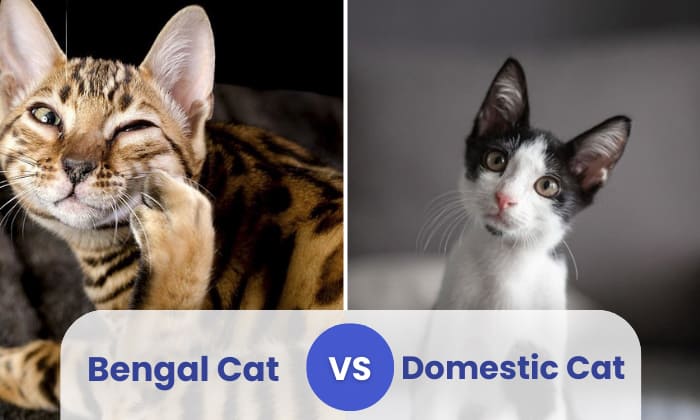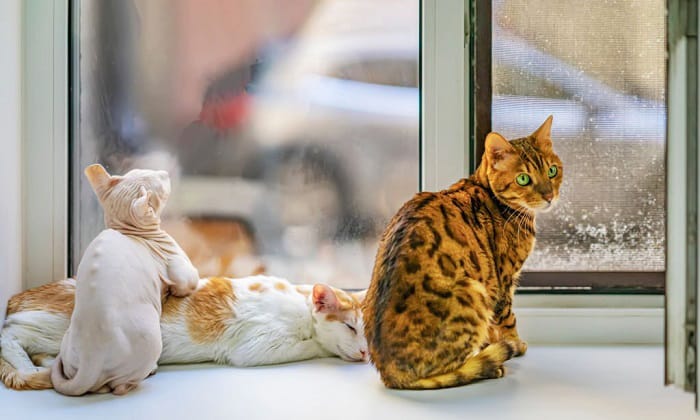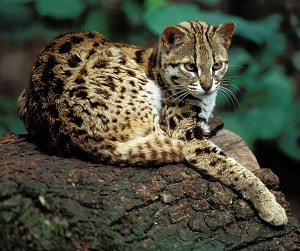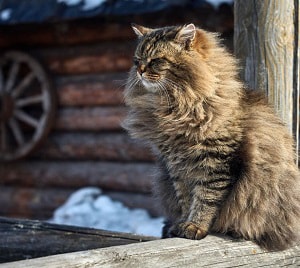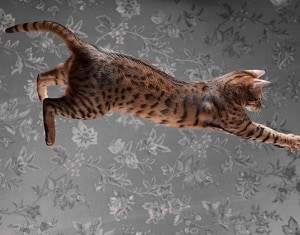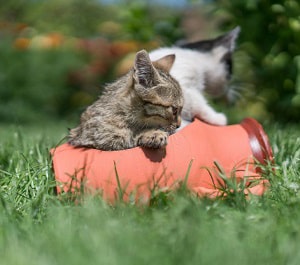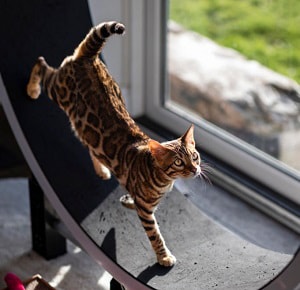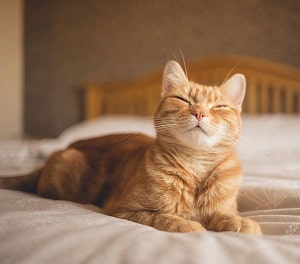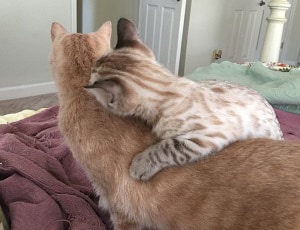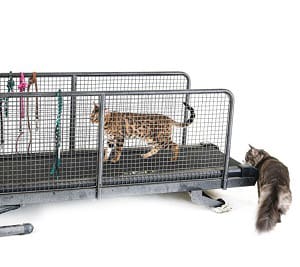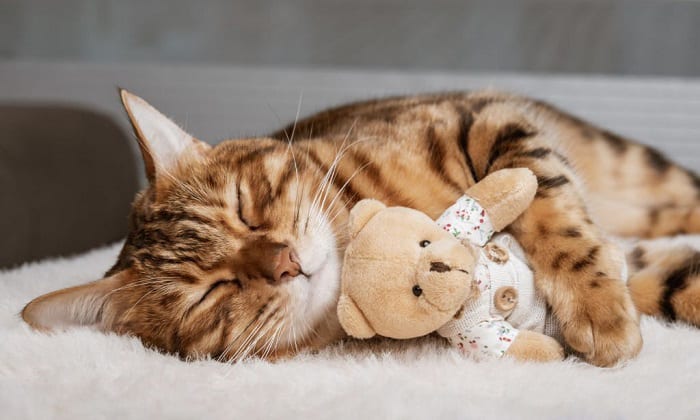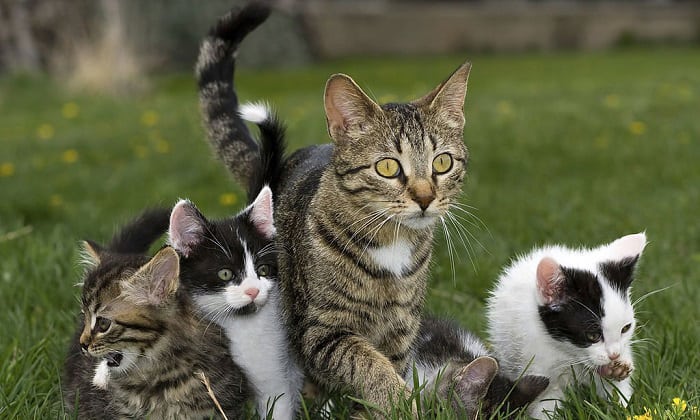Cats are great home pets. They share similar quirky personalities. It is, however, challenging to decipher the differences when their spots or markings are ‘kinda’ the same.
Bengal cat vs domestic cat: which one is it? Do you also need help identifying these two types? Well, you’re not alone.
When you look at a Bengal cat next to a normal cat, the prominent varying feature is in the fur. Bengal has unique rosette markings, while a normal or tabby cat has regular swirl or stripe patterns.
Table of Contents
Bengal Cat and Domestic Cat Comparisons
Learning about Bengal has many advantages. Some unregistered breeders may try to lure you into their scheme—by selling Bengal tabby mix kittens—to make a profit. So, let’s take a look at their comparisons.
Comparison 1: Ancestors
One of the apparent differences between Bengal and domestic cats is their ancestors.
- Bengal History Bengal
Came from the name of its ancestor, the Felis Bengalensis, or Asian Leopard Cat. The breeder wanted to create a home-friendly pet and match the physical trait and some behaviors of the wild counterpart.
The first successful Bengal breeding took place in the United States. The Bengal cat was a mixture of the Asian Leopard and a domestic cat. They did so to preserve the beautiful features of the wild cat while taming it to become an excellent companion.
- Domestic Cat History
Domestic cats became house pets and human companions 4,000 years ago. Back then, they played a significant role, especially in farming communities. Farmers took care of more feline friends to fight against rodents and pests.
Before they got domesticated, the DNA proved that they had been living alongside humans for thousands of years. Later on, cats’ physical traits are more distinct than wild cats. The difference between stripes and dots became more prominent.
Comparison 2: Size
- Bengal Cat Size
The Asian Leopard ancestor of the Bengal cat was almost the same size as a domestic cat. That’s how the breeders and researchers were able to create a hybrid. However, they are more prominent than the usual size of the domesticated ones.
Typically, Bengal’s weight is between 8 and 15. Their slender bodies can grow up to 16 inches long. Although some Bengal and domestic cats are the same weight, the body appearance of Bengal cats is different.
As you can see, Bengals have long, slender, and muscular bodies, which most domestic cats lack. With their bodies, they can do the highest jump and the fastest run.
- Domestic Cat Size
The usual size of a domestic cat is from 9 to 11 pounds. But, it can vary depending on the genes, environment, and health.
Looking at the physiques alone is challenging to determine the difference between Bengal and a domestic cat. So, we will dig deeper.
Comparison 3: Markings and Coatings
Bengal vs. Tabby Domestic Cat
- Bengal
Unlike a tabby cat, a Bengal cat with stripes can be seen with other unique rosette markings. This appearance is also evident in their wild ancestors.
Other than that, you can also notice spotted and marbled coats. They look fantastic, and their fur differs from other tabby, domesticated, or moggie cats. Personally, I love an orange Bengal kitten.
When it comes to coatings, Bengal cats have shiny and soft fur. You can see grey Bengal cats in other shades like snow, silver, and brown.
Since they have short fur, you don’t have to worry about maintenance daily. Just a good brushing once a week will do.
One thing you will love about Bengal cats is that they are hypoallergenic. If you are sensitive to fur but want to own a cat, Bengal is an excellent option.
- Domestic
Domestic cats can have different markings or colors, depending on their breeds and genes. Sometimes, people claim that cats with spots on the belly are Bengals.
At first glance, you might say so. But when you check their fur patterns, you’ll know the reality immediately.
Comparison 4: Activity Level
Cats love to play, but breed also affects their energy level or the frequency of their daily activity. Knowing how active Bengal and domestic cats are, you’ll determine their vital environment.
- Bengal Activity Level
Naturally, Bengals are hunters. Their ancestors survived in the wild without the interference of humans. Although Bengals are domesticated nowadays, they still present wild behaviors.
A Bengal cat, compared to a normal cat, needs more time for play and exercise. They have higher energy and need to release it through everyday activities. As they are athletic, their environment should cater to their physical needs.
- Domestic Cats Activity Level
The energy level of domestic cats can differ depending on the breed, ancestry, and genes. However, most of them have lower energy levels compared to Bengal cats.
As you can notice, domestic cats usually spend more time sleeping. One of the reasons for that is survival. Instinctively, they have to conserve their energy to use for hunting.
Nonetheless, domestic cats still need adequate activity to thrive and prevent future health issues.
Comparison 5: Temperament (Personalities)
The truth is, every cat has its unique traits. But the breed has a significant factor in their personalities.
- Bengal Cats Temperament
Sometimes, people think that Bengal cat characteristics aren’t ideal for pets. But that is only a stereotype. This breed is known to be a friendly and social animal.
Although Bengal has wild origins, breeders only raise the 4th generation of this hybrid cat to ensure that it fully adapted to domestic nature.
Domesticated Bengals are one of a kind since they love the warmth of their owners. It takes time before they acclimate to the environment, but once they trust you enough, they’ll let you in their lives.
Due to their wild nature, they are playful and love to hunt. So, if you have one or plan to have one, make sure to give them a lot of toys and places to climb.
- Domestic Cats Personalities
The environment plays a significant role in your domestic cats. I’ve owned different cats for several years, and I could say they have various personalities. But they have calm, playful, and social traits.
Domestic cats can be great playmates. They also love to sleep all day long and wake you up in the middle of the night due to their scratching, pouncing, and running. Nevertheless, they are wonderful companions.
Comparison 6: Training Needs
Pets can be a handful at times, and if you don’t train them as early as possible, it’s easy to get a lot of scratches on your sofa. So, here are the differences in the training needs between a Bengal and a domestic cat.
- Bengal Training Needs
Since Bengal cats as pets are active and need to use their high energy, they might go overboard with their actions. That’s why discipline and training are crucial.
When training them, treats are helpful rewards. The environment also affects their behaviors. So, if you have Bengal cats, you must have ample space where they can move around and activate their instincts from the wild.
But aside from disciplining them, did you know you can train them in tricks? Yes, definitely. They are smart enough to know how to walk on a leash and even learn how to fetch!
- Domestic Cats Training Needs
Domestic cats can also be trained, but unlike Bengal cats, they can thrive in a slower-paced environment. With enough treats and patience, you can teach them effectively.
How Much is Bengal Cat Price?
The Bengal cat’s average price is between $1500-$3,000. It depends on the maintenance, traits, and genes. Beware of breeders selling Bengal cats for less than $500. It might be a scam or backyard breeding.
Champion-lined Bengal cats are expensive and may cost you $2,500 or more.
Frequently Asked Questions
Are Bengal cats more affectionate?
If compared to other breeds, Bengal striped cats are independent. But they want to spend time with their favorite human, even if they are not fond of cuddling.
Are Bengal cats good house pets?
Yes, they will also make you go crazy as they are more active and would love to play with you all the time!
Which cat can live longer?
Burmese live longer than the usual cat’s lifespan, averaging between 18 to 25 years. The oldest Burmese cat lived for 35 years.
Conclusion
Distinguishing a Bengal cat vs domestic cat can help you decide which home pet is the perfect one for your family. You must remember several factors we’ve shared with you in this article.
Remember that Bengal needs a big enough space to thrive and enjoy daily activities. Weigh in the comparison of having a Bengal and other domestic cats to ensure that you can provide the emotional and physical needs of your soon-to-be new family member.
Read more:

I am Amy Sawy, a Doctor of Veterinary Medicine (DVM) graduate from the University of Kansas. y husband, Dr. Plummer, and I own a veterinary clinic in Phillipsburg, Kansas. In addition to my professional background, I am a devoted pet owner myself, with a household that includes dogs, rodents, and most notably, cats – a total of five felines in my home.
In 2020, I joined an organization as a professional writer, leveraging my experience and collaborating with my team to deliver the most valuable information for your cat’s care.


